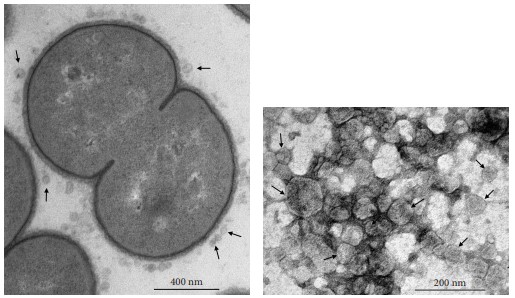Moraxella catarrhalis-derived Exosome Research and Application
Moraxella catarrhalis-derived exosomes are often found in the mucous membranes of the human upper respiratory tract, such as the nose, throat, and lungs, and are involved in maintaining signaling between Moraxella catarrhalis and host cells and regulating host immune responses. Creative Biolabs can provide a one-stop research service to support projects related to Moraxella catarrhalis-derived exosomes, facilitating the exploration of the potential applications of Moraxella catarrhalis-derived exosomes.
Isolation of Moraxella catarrhalis-derived Exosomes
-
Culture Moraxella catarrhalis in brain-heart infusion broth under shaking at 37°C for about 18h.
-
Centrifuge the Moraxella catarrhalis culture medium at low speed, and then filter it to obtain cell-free supernatant.
-
Further concentrate the Moraxella catarrhalis supernatant by ultrafiltration concentration device.
-
Overnight ultracentrifugation and resuspension of Moraxella catarrhalis-derived exosomes with sterile PBS.
-
Verify the sterility of Moraxella catarrhalis-derived exosomes on agar plates to ensure that any contamination by residual bacteria is excluded and used for subsequent analysis.
 Fig. 1 Micrographs of Moraxella catarrhalis secreting vesicles and their exosomes.1
Fig. 1 Micrographs of Moraxella catarrhalis secreting vesicles and their exosomes.1
Studies on Moraxella catarrhalis-derived Exosomes
|
Research
|
Conclusion
|
|
Moraxella catarrhalis-derived exosomes regulated human beta-defensin-2.
|
In human lung epithelial cell models, Moraxella catarrhalis-derived exosomes were found to activate the activation of the human beta-defensin-2 promoter regulated by the inflammatory chemokine IL-1β, which induced the prominent expression of human beta-defensin-2 and the downstream neutrophil chemotactic activity. This was counteracted by the treatment of the neuropeptide calcitonin gene-related peptide and substance P.
|
|
Some concentrations of Moraxella catarrhalis-derived exosomes impaired the cell viability of human lung epithelial cells.
|
The cell viability assay showed that Moraxella catarrhalis-derived exosomes at 20 μg/ml and above significantly delivered cytotoxicity. Further assay by flow cytometry showed that Moraxella catarrhalis-derived exosomes induced apoptosis in human lung epithelial cells.
|
|
Moraxella catarrhalis-derived exosomes effectively induced neutrophil degranulation and promoted inflammation.
|
Quantitative elastase release and granule marker results indicated that Moraxella catarrhalis-derived exosomes mediated inflammation generation and peripheral tissue injury by stimulating neutrophil-specific granule release in a concentration-dependent manner.
|
|
Moraxella catarrhalis-derived exosomes protected pathogens from killing by cationic peptides.
|
Time-kill experiments showed that major human pathogens were able to grow normally by resisting the bactericidal action of cationic peptides in the presence of Moraxella catarrhalis-derived exosomes.
|
|
Moraxella catarrhalis-derived exosomes protected serosensitive strains from complementation.
|
Complement-killing assays revealed that serosensitive strains were resistant to active serum killing after incubation with Moraxella catarrhalis-derived exosomes.
|
|
Moraxella catarrhalis-derived exosomes regulated yeast growth and the mechanism involved.
|
Treatment of Moraxella catarrhalis-derived exosomes favored the retention of toxic filamentous phenotypes in yeast even with antifungal drug effects. Further addition of membrane attack complexes to the assay revealed that Moraxella catarrhalis-derived exosomes contribute to yeast resistance to antimicrobial drugs primarily by isolating cationic peptides.
|
 Fig. 2 Moraxella catarrhalis-derived exosomes favored yeast retention of filaments.2
Fig. 2 Moraxella catarrhalis-derived exosomes favored yeast retention of filaments.2
Moraxella catarrhalis-derived exosomes have been shown to carry a large number of active virulence factors that mediate host pro-inflammatory responses as well as favor innate microbial defenses. Creative Biolabs has an expert perspective on exosome research and provides reliable solutions to help with Moraxella catarrhalis-derived exosome-related research. Please contact us to obtain a quote.
References
-
Augustyniak, Daria, et al. "Neuropeptides SP and CGRP diminish the Moraxella catarrhalis outer membrane vesicle-(OMV-) triggered inflammatory response of human A549 epithelial cells and neutrophils." Mediators of Inflammation 2018 (2018).
-
Roszkowiak, Justyna, et al. "Interspecies outer membrane vesicles (OMVs) modulate the sensitivity of pathogenic bacteria and pathogenic yeasts to cationic peptides and serum complement." International journal of molecular sciences 20.22 (2019): 5577.
For Research Use Only. Cannot be used by patients.
Related Services:

 Fig. 1 Micrographs of Moraxella catarrhalis secreting vesicles and their exosomes.1
Fig. 1 Micrographs of Moraxella catarrhalis secreting vesicles and their exosomes.1
 Fig. 2 Moraxella catarrhalis-derived exosomes favored yeast retention of filaments.2
Fig. 2 Moraxella catarrhalis-derived exosomes favored yeast retention of filaments.2








